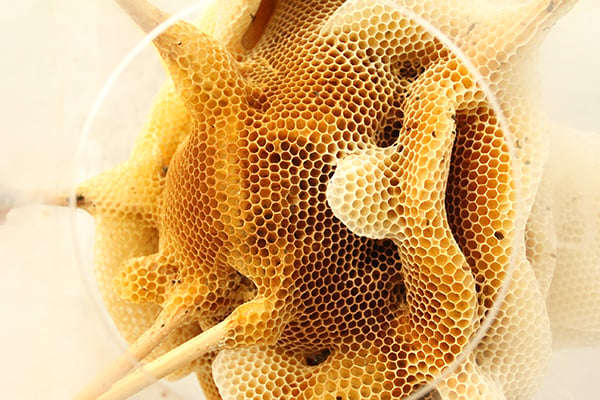
Art is often a collaborative process, but Beijing-based artist Ren Ri has a developed truly unique creative partnership, crafting his work in concert with a hive of bees, reports the Huffington Post. An active beekeeper since 2008, Ren has been grooming his bees’ beeswax output, encouraging his swarm to build its honeycomb structures in visually striking, sculptural forms.
The resulting series of beeswax sculptures, collectively titled “Yuansu II,” are housed within clear plastic containers shaped like squares, polyhedrons, and circles. Ren builds wooden frames for the bees to build upon that extend from the container’s center, where the queen bee dwells, to its edges.
Ren Ri, Yuansu II.
Photo: Alessando De Toni, via Cool Hunting.
As the bees steadily generate beeswax, the artist plays the role of god, rotating the structure once a week (in reference to the Bible’s seven days of creation) to encourage the worker bees to focus their efforts in different directions. Though the results are already unpredictable, Ren increases the random nature of the sculptures by letting a toss of the die determine which direction to turn each piece.
“Beeswax is a very special material; it’s unstable and can change shape with temperature,” Ren told Cool Hunting. ” The structure of the wax cells is orthohexagonal, which is an inconceivable feature in the natural world and it’s a peculiarity of honeybees.”
The artist chose the bee hive as an artistic partner and medium because “I wanted to try to eliminate the subjectivity of the artist and the mediation of bees served this purpose.” This is remarkably similar to the impulse that drove Emil Lukas to start making paintings with fly larvae, a practice he explained at length in a recent artnet News interview.
Ren Ri, Yuansu II.
Photo: Alessando De Toni, via Cool Hunting.
Even as a child, Ren’s dual interest in art and nature was readily apparent: “Back then, I was spending a lot of time observing animals and plants,” the artist explained. “My passion for molding was parallel to an interest for insect ethology.”
The project’s title, “Yuansu,” is based on the Chinese words for element (“yuan”) and mold (“su”), a reference to man’s influence over the planet, shaping, destroying, and interfering with the natural world. Seen inside the clear container, the honeycombed sculptures reflect that tension between the organic and the man-made. It is at once a strange and beautiful reminder of the ongoing struggle between the two forces, and of what can be achieved when we embrace and work in harmony with nature.
“Yuansu II” will be on view at Hangzhou’s T-Museum as part of the exhibition “Fusion-Convergence” through August 7.